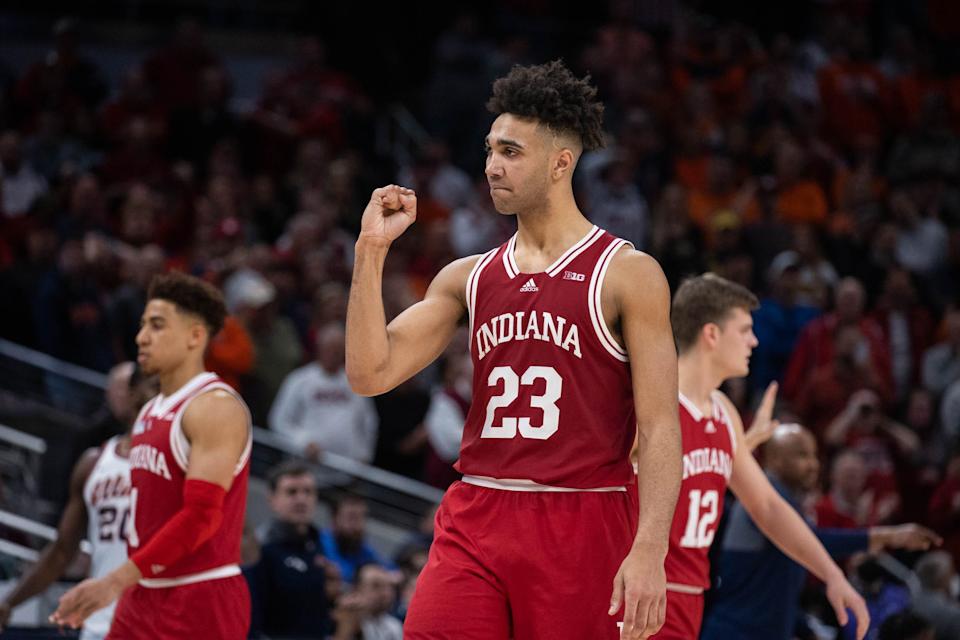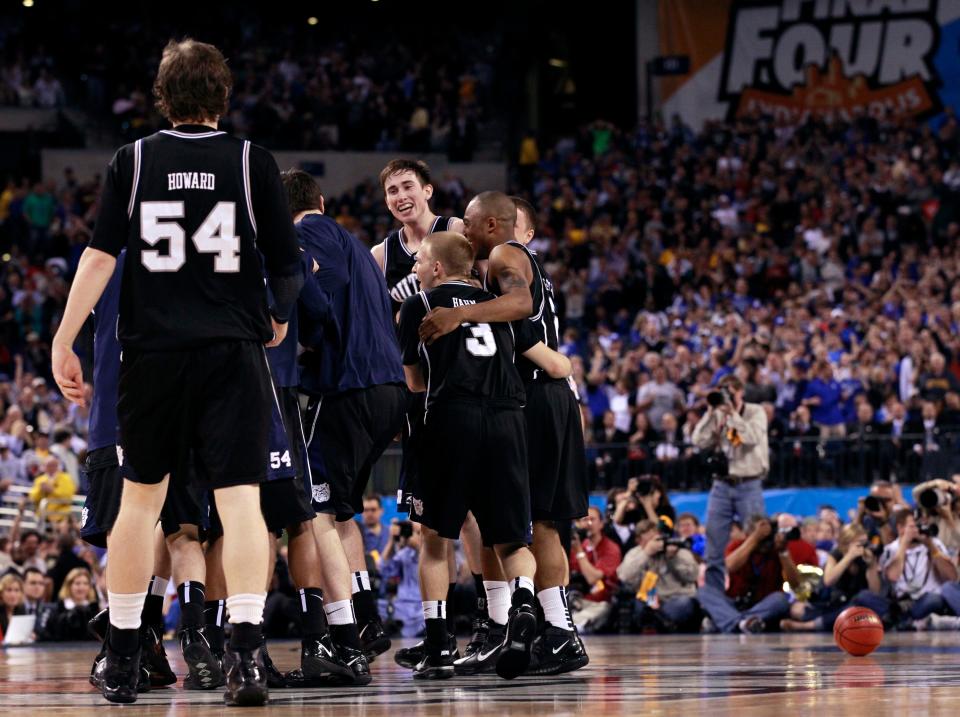How NIL is reshaping college basketball: 'Everything that was a sin is now saintly.'
- Oops!Something went wrong.Please try again later.
This is the third story of a five-part series taking a closer look at name, image and likeness. We'll look at how NIL has changed the game, who enforces what and what the future may hold and more.
BLOOMINGTON – For more than two decades, the ACC/Big Ten Challenge has been a staple of college basketball’s nonconference season.
The annual series, brokered and broadcast by ESPN, pairs nearly every team in the country’s two premier conferences annually, producing some of the best one-off matchups of the sport’s November-December television slate.
This year’s pairings were announced in late June. At the top of the list was a blue-blood tilt between Indiana and North Carolina that might not have been selected had the pre-NBA draft process unfolded differently. Or, perhaps more accurately, had NIL not existed.
The meeting will be headlined by two of the best big men in college basketball, IU’s Trayce Jackson-Davis and UNC’s Armando Bacot.
Jackson-Davis went through a substantial portion of the pre-draft process. While he suggested after withdrawing that NIL opportunities weren’t necessarily at the forefront of his decision to return to school, arrangements with two in-state charities, Pennzoil and Merchants Bank of Indiana — among others — mean Jackson-Davis might have guaranteed himself greater earnings by returning to college than staying in the draft.

Bacot, who declined the predraft process entirely, wasn’t so vague about his reasons for coming back.
“I get a chance to get better,” he told Sports Illustrated’s Michael Rosenberg, “get my degree, be around all my friends and then also make a lot of money.”
How do you regulate NIL?One year in, NIL's biggest problem might be who's in charge. No one is sure.
NIL has forever changed the game.'The NCAA created this monster themselves.'
Bacot’s reasoning offered a window into the way name, image and likeness opportunities have changed the calculus in college basketball. Players might not be so quick to leap for the pros when their earning potential is suddenly this strong in college. More talent will hang around longer.
Will it make the game stronger?
Football is the engine, but basketball turned the key
So much of the conversation around NIL policy, controversy and evolution has been driven by football dollars and football interest that it’s easy to forget basketball put us on the road to where we are today. No single act started the march toward allowing athletes to compensate off their own likeness more so than Ed O’Bannon’s 2009 lawsuit alleging the NCAA should be doing, essentially, just that.
Football has been the engine in the way that it is in so many areas of college athletics, but O’Bannon’s lawsuit turned the key to start it.
“O’Bannon and other (court cases), it took all these years to expose it,” Sonny Vaccaro, the longtime sports marketing executive and power broker in American basketball, told IndyStar. “What did the public do? One way or another, in the world I’ve lived in for a long time, they said, ‘I don’t give a damn how these players get here. I just want to see the games.’”
The result has been a year of upheaval and change, neither of which shows signs of slowing down.
If anything, they’re speeding up, as the SEC and Big Ten pick choice brands off from their rival conferences to expand their footprints, expand their appeal and negotiate fat new TV contracts.
Athletes are benefitting as well. Already just in men’s basketball there are players with NIL deals confirmed to be in the high six and even seven figures. Collectives springing up across the country help facilitate arrangements between athletes and NIL partners, and tap donors and fans for the money to fund them.
Osterman:Like it or not, this is the future of college athletics. Get used to it.

Name, image and likeness has rapidly entrenched itself as an inseparable part of the structure of college basketball, and it isn’t going anywhere.
“The public is endorsing it. Big companies and big boosters are backing it,” Vaccaro said. “Everything that was a sin is now saintly.”
It has undeniably changed locker room dynamics, not often in enormous ways but occasionally very public ones.
When it was announced Kansas State transfer Nigel Pack, a Lawrence Central grad, had received a two-year, $800,000 NIL deal after arriving at Miami, an agent claiming to represent Hurricanes guard Isaiah Wong publicly suggested Wong would consider transferring if he did not receive a similar arrangement. Wong later distanced himself from the comments, the spirit of which seemed to run afoul of rules against NIL deals as inducements. He did not transfer.
By and large, though, name, image and likeness did not seem to fracture the locker room dynamic often (if much at all) in college basketball in Year 1.
Derek Elston, who played at IU from 2009-13 and later spent time on staff in Bloomington, said NIL would likely be absorbed into the already existing mathematics of maintaining positive team chemistry. Elston cited the 2013 Indiana team that won the Big Ten, pointing out stars like Cody Zeller and Victor Oladipo likely would’ve enjoyed the highest earning potential but adding the composition and attitude of that team wouldn’t have allowed something like NIL to become disruptive.
“I wholeheartedly assume if somebody made a lot of money, it was such a tight-knit group that it wouldn’t have mattered who was making what,” Elston said. “We just wanted to win. Put some money in front of us on top of that, that’s just icing on the cake.”
Nevertheless, it’s becoming as much of an influence on players’ behavior as all the old talking points — facilities, development, professional opportunities.
“It’s a lot to wrap your brain around,” one longtime grassroots basketball coach told IndyStar. “There’s no rhyme or reason. It’s off the rails, and everybody thinks they’re going to get paid. Now you’ve got to add an extra column (in recruiting).”
Transfer portal looks 'chaotic, but it's basically what life is.'
It’s also become inextricably intertwined with the transfer portal, a similarly hot-button issue.
By the hundreds in the past two years, college athletes have used the portal and the NCAA’s recently adopted one-time transfer exception to move from one school to another for any variety of opportunities, perceived or real.
Critics say the coupling of the two is pulling apart the fabric of the sport, as players are granted unprecedented freedom of movement and rosters turnover at dizzying speed each offseason. Longtime observers like Vaccaro wonder if that fabric should have been woven differently to begin with.
“It looks chaotic, but it’s basically what life is,” Vaccaro said, alluding to the reality that few college students are beholden to such strictures over where they can attend school. “It looks chaotic because the number (of transfers) is chaotic. But in reality, they should’ve been allowed to do this, and we never would’ve thought about it.”
Prep and AAU basketball coaches see it affecting not just recruits’ decisions, but coaches’ as well.
College basketball has been hit by a series of high-profile retirements (UNC’s Roy Williams, Duke’s Mike Krzyzewski and Villanova’s Jay Wright chiefly among them) in the past two years. Not all were necessarily related to NIL, but behind closed doors, some active coaches are looking for a path out of the college game, disinterested in managing the uncertainty of this new era.
Still, others have taken a different attitude. Many embrace name, image and likeness, putting it front and center as part of the day-to-day experience within their programs. States with NIL laws are currently rewriting them to allow athletics department personnel to help facilitate deals for athletes, which could in theory allow coaches to take an even more active role. And some high-profile veterans in the industry have been outspoken about the need to replace complaint with action.
“This is the world we're in,” Notre Dame coach Mike Brey told ESPN last spring, “and last time I checked, we make pretty good money. So everybody should shut up and adjust.”
A threat to March Madness?
Bigger, more philosophical questions have also begun to enter the slipstream.
NIL is among a number of change agents affecting college sports right now, alongside College Football Playoff expansion, conference realignment, the continued autonomy push and other issues.
As Playoff expansion discussions intensify, industry leaders are talking openly about pulling football completely away from the NCAA and into some new governing structure. Ohio State AD Gene Smith and Pac-12 Commissioner George Kliavkoff have both raised the possibility in different ways in recent months.
If football is spun off entirely — and likely run with heavy input from the sport’s most powerful conferences and programs — some in college athletics have begun to wonder if basketball could walk a similar path eventually.
While it does not generate the same level of income as football, basketball (and more specifically the NCAA tournament) is college sports’ other billion-dollar product. If the old order is discarded for one sport, might it be for the other?
Possibly. But there are numerous reasons for skepticism, or at very least prudence.
The NCAA has long held a much greater controlling interest in basketball, where it manages the sport’s lucrative postseason, than in football. Unlike the Playoff, which sees its initial contract expire after the 2025 season, the current contract between the NCAA and broadcast partners CBS and Turner Sports has been extended through 2032.

And unlike football, which has often been a closed shop reserved for an elite few at the top end of the sport, basketball’s postseason sells something a Power Five breakaway likely couldn’t: the underdog.
“More so than anything,” Vaccaro said, “Cinderella has a chance to get to the ball. Cinderella’s never going to be at the ball in football.”
As with so much that surrounds name, image and likeness, its continuing impact on college basketball will only clarify as it evolves. There will be positive consequences and negative ones, and plenty of disagreement over which developments are truly which.
“College basketball players,” Vaccaro said, “are going to have a much better life than all their predecessors.”
In the meantime, expect to see more athletes signing and publicizing major NIL deals, and expect more of them to stay in school longer because of it.
NIL has helped redress at least some of the power imbalance between college and the NBA in talent retention, as college becomes more lucrative for some borderline prospects than a two-way contract or a path through the G League.
And expect, therefore, a few more matchups like the one slated for Nov. 30 in Bloomington, when two big men who might otherwise have turned pro go hammer and tongs at one another for 40 minutes in one of basketball’s most venerated arenas, on one of its largest possible stages.
Follow IndyStar reporter Zach Osterman on Twitter: @ZachOsterman.
This article originally appeared on Indianapolis Star: NCAA basketball: How NIL affects NBA decisions, transfer portal, more

